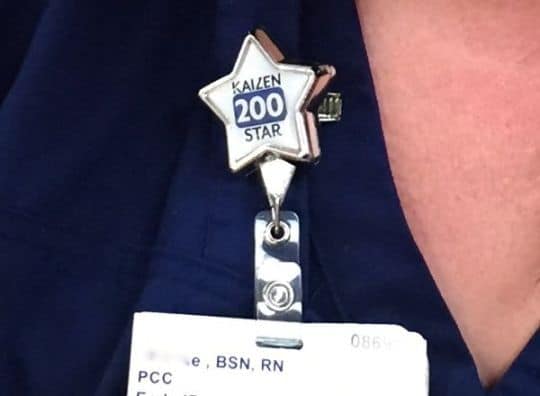Franciscan St Francis Health System Continuous Improvement
A Visit to Franciscan St. Francis Health: A Workforce "Unleashed" by Kaizen
Last week, I had the opportunity to spend a day with my Healthcare Kaizen co-author Joe Swartz and his colleagues at one of the three hospitals in the Franciscan St. Francis Health system. It was my second visit and, like the first, it reinforced my view that a culture of continuous improvement really is possible – and when you see it, it's a wonderful thing. It's even better to work in it.
The people of Franciscan have implemented and documented more than 20,000 Kaizen improvements over the past seven years. In most recent years, they have had between employee participation rates in the mid 30% to mid 40% ranges. Those are participation rates that most organizations would love to have, along with the measurable benefits – more than $5 million in hard cost savings, along with improvements to patient satisfaction, quality, and employee engagement.
Staff get to wear a special badge holder when they hit milestones about how many Kaizens they have implemented — 200 for one nurse! She's a "Kaizen Star!"

I was asked to give a presentation about how to engage everybody in continuous improvement – a noble and important goal. They might be the only hospital to be visited by both Norman Bodek and Masaaki Imai, two men who have done as much as anybody to spread Kaizen. I humbly follow in their footsteps. In my talk, I shared some stories from other organizations that have gotten started with Kaizen, including other hospitals and Catholic Charities Fort Worth (where I've done some pro-bono work).
Rather than trying to stand on a stage to tell Franciscan what to do, I tried to draw out ideas from leaders in the audience. There are some departments where virtually everybody IS participating in Kaizen. "What are those leaders doing?," I asked. "How can we use Kaizen principles to improve how we do Kaizen?"
I proposed that the answers were already in the room and just needed to shared and emulated more broadly. In the Kaizen approach, improvements are not just tested and implemented – they are documented and shared (through a home-grown web database they've created, along with other more analog methods).
Those leadership practices and leader behaviors from the departments with near 100% participation can be shared with other leaders. Franciscan already tries to encourage friendly competition, within teams and between departments by posting data about participation levels. The easiest thing to measure is the number of Kaizens and the percentage of people participating. The impact of those Kaizens also matters too, as leaders try to keep their employees connected to the mission and purpose of their work.
We brainstormed ways that leaders can share ideas about how to improve how they improve. They had many ideas and, in the spirit of Kaizen, I shared an idea from one of my clients who is planning to have occasional internal "Kaizen Conferences" to compare notes on what is working best throughout the health system to encourage Kaizen.
The answers are often right around us if we humbly inquire and compare notes. I admire Franciscan leaders for not blaming employees who don't participate in Kaizen. They are challenging themselves to create environments where people want to do Kaizen. The leaders set the tone for their employees.
One department we visited was endoscopy. Joe and I interviewed leaders and a number of nurses. The teamwork was apparent, as the nurses wanted to talk to us in groups because most of their Kaizen work is done in small groups. There is a letter "i" in the word Kaizen, but it's really more of a "we" thing than an "I thing." They find joy in their improvement work, mainly for the intrinsic rewards that it brings (and the tangible benefits to their patients). A team of 30 people has implemented over 750 improvements so far this year, making them one of the highest-performing departments in the system.
The one word that got used a lot by staff and leaders was that they felt "unleashed" to use their creativity, to take action, and to do the right things for their patients and their co-workers. The imagery of that word "unleashed" makes one pause and think about organizations that figuratively "leash" their employees, as if to keep them from running off and doing things. Are we trying to get employees to behave or do we want them to improve and innovate?
At Franciscan, and in my visits to other hospitals, I've found the bottleneck in the improvement process is hardly ever a lack of employee ideas. People working in healthcare care deeply about their work and their patients. They are smart and creative. They can do great things, through the practice of Kaizen – identify and solving dozens or hundreds of improvements in their department.
What holds back improvement and innovation? It's the organization's culture and the behavior of managers and senior leaders. Most organizations say they want a "culture of continuous improvement" (just check the websites of health systems).
If you ever find yourself complaining that you team doesn't have a culture of continuous improvement, don't blame the employees – look in the mirror and think about what you're doing (or not doing) as a manager. If you're a senior leader, look in the mirror and reflect upon what behaviors of yours stifle Kaizen and which behaviors encourage and support Kaizen. It starts with you.
I'll be writing more posts about the visit to Franciscan – it really is inspiring.
What do you think? Scroll down to comment or share your thoughts and the post on social media. Don't want to miss a post or podcast? Subscribe to get notified about posts via email daily or weekly.
- About
- Latest Posts

Source: https://www.leanblog.org/2014/10/a-visit-to-franciscan-st-francis-health-a-workforce-unleashed/
0 Response to "Franciscan St Francis Health System Continuous Improvement"
Post a Comment